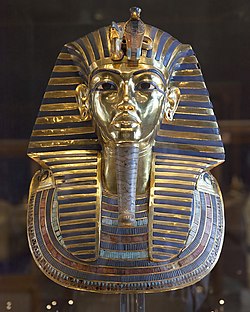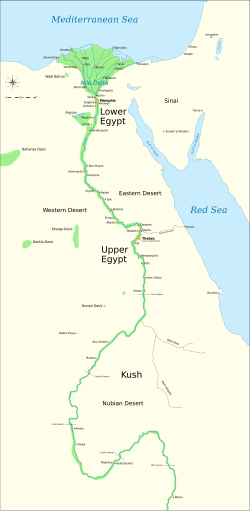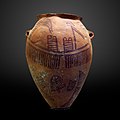Portal:Ancient Egypt
|
THE ANCIENT EGYPT PORTAL
Showcased content about Ancient Egypt Ancient Egypt (Egyptian: km.t) was a cradle of civilization concentrated along the lower reaches of the Nile River in Northeast Africa. It emerged from prehistoric Egypt around 3150 BC (according to conventional Egyptian chronology), when Upper and Lower Egypt were amalgamated by Menes, who is believed by the majority of Egyptologists to have been the same person as Narmer. The history of ancient Egypt unfolded as a series of stable kingdoms interspersed by the "Intermediate Periods" of relative instability. These stable kingdoms existed in one of three periods: the Old Kingdom of the Early Bronze Age; the Middle Kingdom of the Middle Bronze Age; or the New Kingdom of the Late Bronze Age. The pinnacle of ancient Egyptian power was achieved during the New Kingdom, which extended its rule to much of Nubia and a considerable portion of the Levant. After this period, Egypt entered an era of slow decline. Over the course of its history, it was invaded or conquered by a number of foreign civilizations, including the Hyksos, the Kushites, the Assyrians, the Persians, and, most notably, the Greeks and then the Romans. The end of ancient Egypt is variously defined as occurring with the end of the Late Period during the Wars of Alexander the Great in 332 BC or with the end of the Greek-ruled Ptolemaic Kingdom during the Roman conquest of Egypt in 30 BC. In AD 642, the Arab conquest of Egypt brought an end to the region's millennium-long Greco-Roman period. The success of ancient Egyptian civilization came partly from its ability to adapt to the Nile's conditions for agriculture. The predictable flooding of the Nile and controlled irrigation of its fertile valley produced surplus crops, which supported a more dense population, and thereby substantial social and cultural development. With resources to spare, the administration sponsored the mineral exploitation of the valley and its surrounding desert regions, the early development of an independent writing system, the organization of collective construction and agricultural projects, trade with other civilizations, and a military to assert Egyptian dominance throughout the Near East. Motivating and organizing these activities was a bureaucracy of elite scribes, religious leaders, and administrators under the control of the reigning pharaoh, who ensured the cooperation and unity of the Egyptian people in the context of an elaborate system of religious beliefs.[1] Among the many achievements of ancient Egypt are: the quarrying, surveying, and construction techniques that supported the building of monumental pyramids, temples, and obelisks; a system of mathematics; a practical and effective system of medicine; irrigation systems and agricultural production techniques; the first known planked boats; Egyptian faience and glass technology; new forms of literature; and the earliest known peace treaty, which was ratified with the Anatolia-based Hittite Empire. Its art and architecture were widely copied and its antiquities were carried off to be studied, admired, or coveted in the far corners of the world. Likewise, its monumental ruins inspired the imaginations of travelers and writers for millennia. A newfound European and Egyptian respect for antiquities and excavations that began in earnest in the early modern period has led to much scientific investigation of ancient Egypt and its society, as well as a greater appreciation of its cultural legacy. (Full article...) Selected article - The Eye of Ra or Eye of Re, usually depicted as sun disk or right wedjat-eye (paired with the Eye of Horus, left wedjat-eye), is an entity in ancient Egyptian mythology that functions as an extension of the sun god Ra's power, equated with the disk of the sun, but it often behaves as an independent goddess, a feminine counterpart to Ra and a violent force that subdues his enemies. This goddess, also known with the theonym Wedjat, can be equated with several particular deities, including Hathor, Sekhmet, Bastet, Raet-Tawy, Menhit, Tefnut, and Mut. The eye goddess acts as mother, sibling, consort, and daughter of the sun god. She is his partner in the creative cycle in which he begets the renewed form of himself that is born at dawn. The eye's violent aspect defends Ra against the agents of disorder that threaten his rule. This dangerous aspect of the eye goddess is often represented by a lioness or by the uraeus, or cobra, a symbol of protection and royal authority. The disastrous fury and rampages of the eye goddess and the efforts of the gods to appease her are a prominent motif in Egyptian mythology. The Eye of Ra was involved in many areas of ancient Egyptian religion, including in the cults of the many goddesses who are equated with it. Its life-giving power was celebrated in temple rituals, and its dangerous aspect was invoked in the protection of the pharaoh, of sacred places, and of ordinary people and their homes. (Full article...) Selected picture
In antiquity, Ancient Egypt was divided into two lands: Upper Egypt and Lower Egypt. To the south, it was bounded by the land of Kush, and to the East, the levant. Surrounded by harsh deserts, the river Nile was the lifeline of this ancient civilization. Did you know...
News5th September 2018. Rock-cut Tomb discovered in a 4,000-year-old Elite Cemetery August 2018: in the tomb of the mayor of Memphis Ptahmose who dates around 1300 BC was found well preserved cheese, more than 3000 years old. [1] Selected biography -Maaibre Sheshi (also Sheshy) was a ruler of areas of Egypt during the Second Intermediate Period. The dynasty, chronological position, duration and extent of his reign are uncertain and subject to ongoing debate. The difficulty of identification is mirrored by problems in determining events from the end of the Middle Kingdom to the arrival of the Hyksos in Egypt. Nonetheless, Sheshi is, in terms of the number of artifacts attributed to him, the best-attested king of the period spanning the end of the Middle Kingdom and the Second Intermediate period; roughly from c. 1800 BC until 1550 BC. Hundreds of scaraboid seals bearing his name have been found throughout the Levant, Egypt, Nubia, and as far away as Carthage, where some were still in use 1,500 years after his death. Three competing hypotheses have been put forth for the dynasty to which Sheshi belonged. The first hypothesis is supported by Egyptologists such as Nicolas Grimal, William C. Hayes, and Donald B. Redford, who believe that he should be identified with Salitis, founder of the 15th Dynasty according to historical sources and king of the Hyksos during their invasion of Egypt. Salitis is credited with 19 years of reign and would have lived sometime between c. 1720 BC and 1650 BC. The second hypothesis is supported by Egyptologist William Ayres Ward and the archaeologist Daphna Ben-Tor, who propose that Sheshi was a Hyksos king and belongs to the second half of the 15th Dynasty, reigning between Khyan and Apophis. Alternatively, Manfred Bietak has proposed that Sheshi was a vassal of the Hyksos, ruling over some part of Egypt or Canaan. The very existence of such vassals is debated. The final hypothesis says Sheshi could be a ruler of the early 14th Dynasty, a line of kings of Canaanite descent ruling over of the Eastern Nile Delta immediately before the arrival of the Hyksos. Proponents of this theory, such as Kim Ryholt and Darrell Baker, credit Sheshi with 40 years of reign starting ca. 1745 BC. (Full article...) General imagesThe following are images from various ancient Egypt-related articles on Wikipedia.
Related portalsWikiProjectsMain topics
Notable Pharaohs
CategoriesRecognized content
Featured articles
Featured listsGood articles
Did you know? articles
Featured pictures
In the News articlesMain page featured articles
Main page featured listsPicture of the day pictures
Things to do
WikimediaThe following Wikimedia Foundation sister projects provide more on this subject:
Sources
Discover Wikipedia using portals |









































































